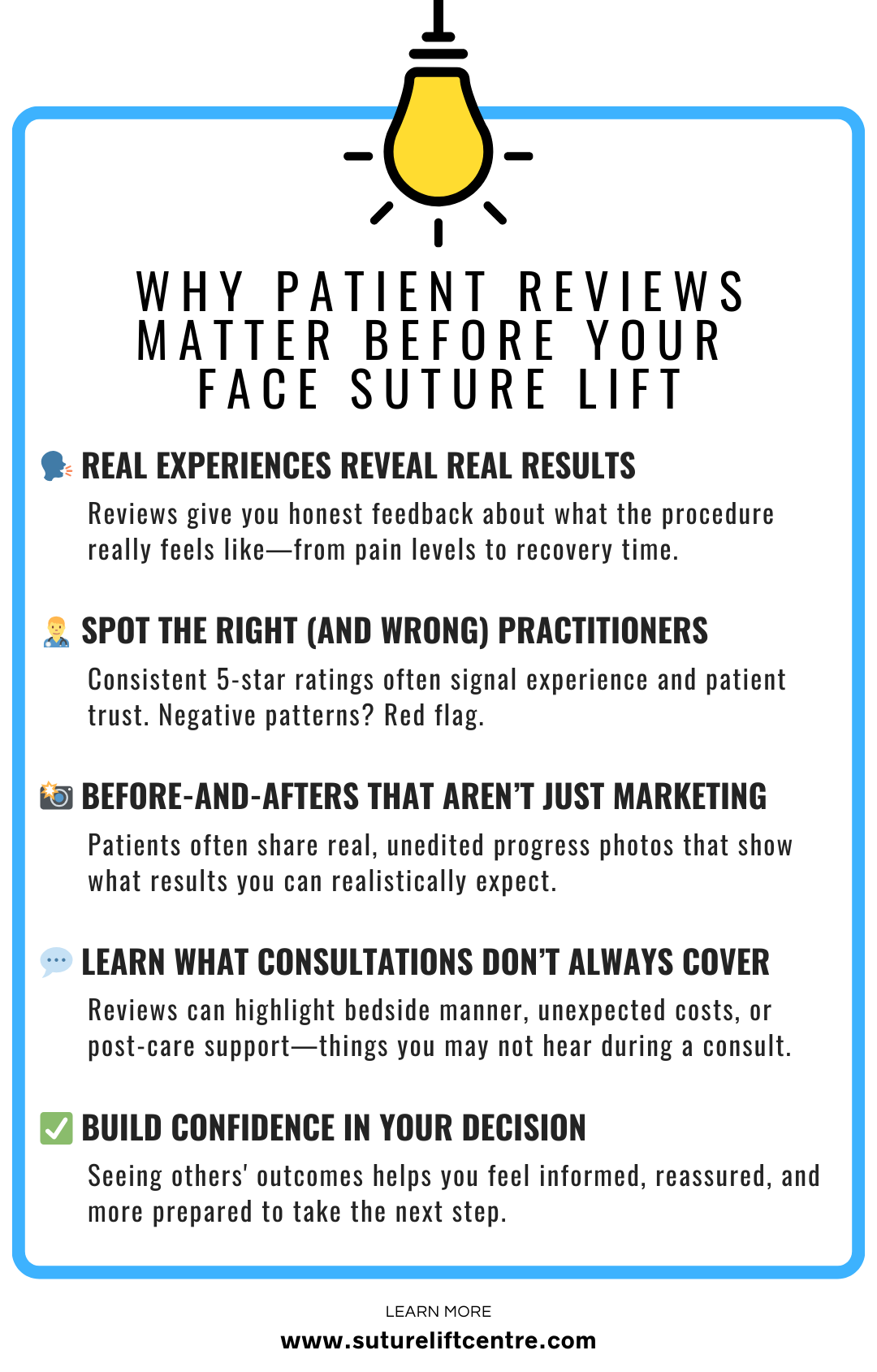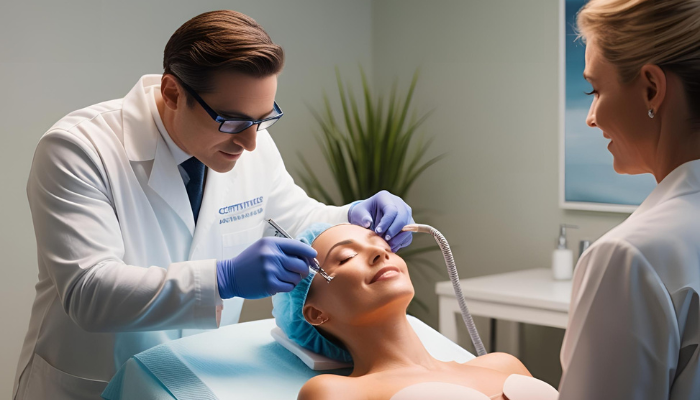This “lunchtime lift” promises subtle results with minimal downtime — but the real secret isn’t just in the threads. It’s in who’s doing the lifting.
In this post, we’ll break down what really matters when choosing a specialist — including a few tips most people overlook. If you’re curious, cautious, or just getting started, read on. You might be surprised at what makes all the difference.
Key Takeaways
- Look for a certified face suture lift specialist with a solid educational background.
- Check reviews and testimonials to gauge the specialist’s reputation.
- Have a clear idea of your desired outcomes before your consultation.
- Understand the procedure and what to expect during recovery.
- Consider the safety of the procedure and the importance of aftercare.
Understanding Suture Lifts

What Is a Suture Lift?
A suture lift is a minimally invasive procedure designed to lift and rejuvenate the face without the extensive surgery of a traditional facelift. It’s a fantastic option if you’re noticing early signs of sagging and want a refreshed look without a long recovery.
How Does a Suture Lift Work?
Special medical-grade threads are inserted beneath the skin to lift and support sagging tissues. These sutures have tiny barbs or cones that grip the skin, allowing the doctor to gently lift and reposition the skin. The procedure is performed using local anaesthetic, so it’s relatively comfortable.
The best part? The sutures also stimulate collagen production, which helps to improve skin firmness and elasticity over time.
Benefits of Choosing a Suture Lift
Why should you consider a suture lift? Here are a few reasons:
- Minimally Invasive: No large incisions, less risk of scarring.
- Quick Recovery: Downtime is minimal, so you can get back to your life sooner.
- Natural-Looking Results: Subtle enhancements that refresh your appearance without looking “done.”
- Long-Lasting Effects: Suture lifts provide long-lasting effects, often considered semi-permanent, especially when compared to dissolvable thread lifts. However, aging and lifestyle factors can still impact results over time.
- Collagen Stimulation: The sutures promote collagen production, improving skin quality over time.
A suture lift offers a fantastic solution for those seeking subtle yet effective facial rejuvenation. It’s a great way to address early signs of ageing and achieve a more youthful, refreshed appearance with minimal disruption to your daily life. It’s all about enhancing your natural beauty and helping you feel more confident in your own skin.
Identifying Qualified Specialists
Choosing the right specialist for a suture lift is really important. You want someone who knows what they’re doing and can give you the results you’re hoping for.
Don’t just look for someone who offers suture lifts — choose a practitioner with proven expertise and training in the technique.
Importance of Certification
Certification is a key indicator of a specialist’s competence and training. It means they’ve met certain standards and have the necessary skills to perform the procedure safely and effectively.
Don’t be afraid to ask about their qualifications and verify their credentials. Think of it like this:
- Certification shows commitment to ongoing education.
- It ensures adherence to industry best practises.
- It often involves rigorous testing and assessment.
It’s always a good idea to check with professional medical boards to confirm that your chosen specialist is indeed certified and in good standing. This simple step can give you peace of mind.
Evaluating Experience and Expertise
Experience counts for a lot in this field. Look for a specialist who has performed a significant number of suture lift procedures. Experience often translates to better outcomes and fewer complications.
Consider these points when evaluating experience:Ask about their experience, and don’t hesitate to ask for before-and-after photos of their previous patients. Consider these points when evaluating experience:
- How many suture lift procedures have they performed?
- Do they specialise in facial aesthetics?
- What is their approach to patient care?
Reading Patient Reviews
Patient reviews can offer valuable insights into a specialist’s skills and bedside manner. Look for reviews on independent websites and forums, not just on the specialist’s own website.
Pay attention to both positive and negative feedback, and consider the overall trend. What are other patients saying about their experience?

Here’s what to look for in patient reviews:
- Comments on the specialist’s communication skills.
- Feedback on the results of the procedure.
- Mentions of any complications or issues encountered.
Assessing Your Personal Goals
Before diving into the specifics of a suture lift, it’s really important to take a step back and think about what you’re hoping to achieve. This isn’t just about looking younger; it’s about feeling more confident and comfortable in your own skin.
Let’s break down some key areas to consider.
Defining Your Desired Outcomes
What exactly are you hoping to change with a suture lift? Are you looking to lift sagging cheeks, redefine your jawline, or smooth out wrinkles? Being clear about your goals will help you and your specialist determine if a suture lift is the right solution for you.
It also helps to manage your expectations and ensure you’re both on the same page. Think about:
- Specific areas you want to target.
- The degree of change you’re looking for (subtle vs. noticeable).
- How you want to feel after the procedure.
Understanding Your Skin Type
Your skin’s elasticity and overall condition play a big role in the success of a suture lift. Some skin types respond better to the procedure than others. For example, if you have very thin skin, you might need to consider alternative options.
Factors like sun damage, smoking, and genetics can also affect your skin’s ability to heal and respond to the lift. It’s worth considering:
- Your skin’s thickness and elasticity.
- Any existing skin conditions (e.g., rosacea, eczema).
- Your history of sun exposure and skincare routine.
Setting Realistic Expectations
Suture lifts can provide fantastic, natural-looking results, but it’s important to have realistic expectations. A suture lift is a subtle enhancement, not a complete transformation.
It can lift and tighten sagging skin, but it won’t stop the ageing process altogether. It’s also important to remember that results can vary depending on individual factors like skin type and lifestyle.
Think of a suture lift as a way to refresh your appearance and turn back the clock a little, rather than completely reinventing yourself. It’s about enhancing your natural beauty and helping you feel more confident, but it’s not a magic wand. Having a clear understanding of what the procedure can and can’t achieve will help you avoid disappointment and ensure you’re happy with the outcome.
Exploring the Procedure
It’s natural to feel a bit anxious about any procedure, so let’s break down what you can expect with a suture lift. Knowing the steps involved can really help put your mind at ease.
We’ll cover everything from the initial chat to what happens after the procedure, so you’re fully prepared.
What to Expect During the Consultation
The consultation is your opportunity to get all your questions answered and ensure a suture lift is the right choice for you. During this appointment, the specialist will discuss your aesthetic goals, assess your skin, and explain the procedure in detail. Be ready to share what concerns you about your current appearance — the more specific you are, the better the treatment can be tailored to your needs.
Your medical history will also be reviewed to identify any potential risks. It’s a two-way conversation, so don’t hesitate to speak up. Photos may be taken as part of the planning process and to track your progress over time.
Step-by-Step Overview of the Procedure
So, what actually happens during a suture lift? Here’s a quick rundown:
- Preparation: The treatment area is thoroughly cleaned, and a local anaesthetic is applied to ensure comfort throughout the procedure.
- Suture Placement: Tiny entry points are made with a needle to insert the sutures — no large incisions are required.
- Lifting and Contouring: The sutures are gently pulled to lift and reposition the skin, creating a more youthful, defined contour.
- Securing the Sutures: Once the desired lift is achieved, the sutures are secured in place, and any excess is trimmed.
- Closure: The small entry points are closed, typically with tiny stitches or surgical tape, requiring minimal downtime.
The entire process is typically quick, with most procedures completed in under an hour.
Post-Procedure Care and Recovery
After the suture lift, it’s important to follow the aftercare instructions to ensure a smooth recovery. You might experience some mild swelling, bruising, or discomfort, but this is usually temporary and can be managed with pain relief.
Here are a few tips:
- Apply cold compresses to reduce swelling.
- Avoid strenuous activities for a week or two.
- Sleep on your back with your head elevated.
- Follow the cleaning instructions provided.
It’s normal to have some initial concerns, but most patients find the recovery period quite manageable. The results will gradually improve over the following weeks as any swelling subsides and the skin settles into its new position. Remember, I’m always here to answer any questions or address any concerns you might have during your recovery.
Comparing Suture Lifts and Thread Lifts

Key Differences Between the Two
When exploring facial rejuvenation, you’ll likely encounter both suture lifts and thread lifts. It’s easy to get them mixed up, but they’re actually quite different. The main thing to remember is that a suture lift is a more permanent solution, while thread lifts offer a temporary fix.
Suture lifts involve carefully placing sutures beneath the skin to lift and support sagging tissues, providing a lasting, natural-looking result. Thread lifts, on the other hand, use threads that dissolve over time, meaning the lift is only temporary.
Longevity of Results
One of the biggest differences between suture lifts and thread lifts is how long the results last. Suture lifts are designed to be permanent, offering a long-term solution for facial rejuvenation. The sutures used in the procedure are carefully placed to provide lasting support and lift.
Thread lifts, however, use threads that dissolve over time, typically within a few months to a year. This means the results are temporary, and you’ll need to repeat the procedure to maintain the lifted look.
Choosing the Right Option for You
Deciding between a suture lift and a thread lift really depends on what you’re hoping to achieve and how long you want the results to last. If you’re looking for a more permanent solution with natural-looking results, a suture lift is likely the better choice. It’s a minimally invasive procedure with little downtime, and it can provide a lasting lift and contour to your face.
If you’re not ready for a permanent commitment, a thread lift might be a good starting point. However, keep in mind that you’ll need to repeat the procedure to maintain the results. Ultimately, the best way to decide is to have a consultation to discuss your goals and assess your individual needs.
Choosing the right procedure depends on your desired outcome and commitment to longevity. A suture lift offers a permanent solution, while thread lifts provide a temporary enhancement. Consider your lifestyle, budget, and aesthetic goals when making your decision.
Safety Considerations
It’s natural to wonder about safety when considering any cosmetic procedure, and suture lifts are no different. The good news is that suture lifts are generally considered safe, but it’s important to be aware of potential risks and how to minimise them.
Let’s break down the key things to keep in mind.
Understanding Potential Risks
Like all medical procedures, suture lifts come with potential risks, though serious complications are rare. Common side effects include some swelling, bruising, and mild discomfort in the days following the procedure. These usually resolve on their own. Infection is a possibility, but it’s minimised by following proper hygiene and aftercare instructions.
In some cases, patients might experience suture migration or extrusion, where the suture shifts or becomes visible under the skin. This is usually easily corrected by your specialist. It’s also worth remembering that results can vary, and there’s a small chance you might not achieve the exact outcome you were hoping for.
Importance of Aftercare
Proper aftercare is vital for a smooth recovery and to minimise the risk of complications. Your specialist will provide detailed instructions, and it’s important to follow them carefully. This typically includes:
- Avoiding strenuous activities for a few weeks.
- Sleeping on your back to prevent pressure on the treated area.
- Applying cold compresses to reduce swelling.
- Taking any prescribed medications as directed.
- Attending all follow-up appointments so your specialist can monitor your progress.
Adhering to these guidelines will not only help you heal faster but also ensure the best possible outcome from your suture lift. Think of it as an investment in your results and your well-being.
Recognising Signs of Complications
While complications are uncommon, it’s important to know what to look out for. Contact your specialist immediately if you experience any of the following:
- Signs of infection, such as increased redness, swelling, pain, or pus.
- A sudden increase in pain or discomfort.
- Noticeable suture migration or extrusion.
- Any other unusual symptoms that concern you.
Being proactive and seeking prompt medical attention can help prevent minor issues from becoming more serious. Remember, your specialist is there to support you throughout the entire process, so don’t hesitate to reach out with any questions or concerns.
The Role of Technology in Suture Lifts
Innovations in Suture Materials
Suture materials have come a long way, and it’s pretty cool to see what’s new. Modern sutures used in suture lifts are designed with specific properties to enhance the lifting effect and promote better tissue integration.
- Barbed Sutures: These have tiny barbs that grip the skin, providing a stronger hold and lift.
- Cone Sutures: These use cones to anchor the skin, distributing tension more evenly.
- Biodegradable Materials: While some techniques may use biodegradable threads for added collagen stimulation, suture lifts intended for long-lasting results typically rely on more durable sutures.
Advancements in Techniques
It’s not just the materials that are improving; the techniques are getting smarter too. Specialists are now using advanced imaging and planning tools to map out the suture placement with greater precision. This helps to achieve more predictable and natural-looking results.
- 3D Imaging: Some clinics use 3D imaging to assess facial structure and plan the lift.
- Vector Analysis: This helps to determine the optimal direction and tension for the sutures. Some specialists use facial mapping techniques to plan the most effective lift directions.
- Minimally Invasive Instruments: Smaller, more precise instruments reduce trauma to the skin and speed up recovery.
Impact on Patient Outcomes
All these technological advancements are making a real difference for patients.
- Improved Results: More precise lifts with better contouring.
- Reduced Downtime: Less invasive techniques mean quicker recovery times.
- Increased Safety: Advanced materials and techniques minimise the risk of complications.
Technology is changing the game when it comes to suture lifts. It’s allowing us to achieve better, more natural-looking results with less downtime and risk. If you’re considering a suture lift, it’s worth asking your specialist about the latest innovations and how they can benefit you.
Conclusion
Choosing the right face suture lift specialist isn’t just about getting great results — it’s about protecting your safety, boosting your confidence, and making sure the procedure truly fits your goals. The more informed you are, the better decisions you’ll make.
So take your time. Ask questions. Look for experience, transparency, and someone who listens to you.
Your face deserves thoughtful care, not rushed choices. With the right guidance and a clear understanding of what to look for, you’re more than ready to take the next step — confidently and on your terms.
Frequently Asked Questions
What is a suture lift?
A suture lift is a simple procedure that lifts and tightens the skin using special threads without the need for major surgery. It’s a great way to refresh your look.
How does a suture lift work?
During a suture lift, tiny threads are inserted under the skin to lift sagging areas. These threads have little hooks that help hold the skin in place.
What are the benefits of a suture lift?
Suture lifts are less invasive, have quick recovery times, and provide natural-looking results. They also help your skin produce more collagen, which improves skin quality.
How long do the results of a suture lift last?
The results of a suture lift can be long-lasting, often permanent, depending on the individual and their skin type.
Are there any risks associated with suture lifts?
Like any procedure, there are some risks, such as swelling or infection. It’s important to follow aftercare instructions to minimise these risks.
How can I find a qualified suture lift specialist?
Look for a certified specialist with experience in suture lifts. Reading patient reviews and checking their qualifications can also help you choose the right practitioner.




